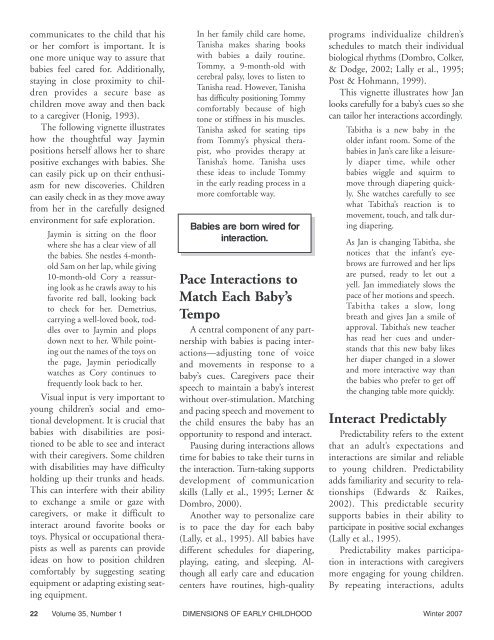Dimensions of Early Childhood - Southern Early Childhood ...
Dimensions of Early Childhood - Southern Early Childhood ...
Dimensions of Early Childhood - Southern Early Childhood ...
You also want an ePaper? Increase the reach of your titles
YUMPU automatically turns print PDFs into web optimized ePapers that Google loves.
communicates to the child that his<br />
or her comfort is important. It is<br />
one more unique way to assure that<br />
babies feel cared for. Additionally,<br />
staying in close proximity to children<br />
provides a secure base as<br />
children move away and then back<br />
to a caregiver (Honig, 1993).<br />
The following vignette illustrates<br />
how the thoughtful way Jaymin<br />
positions herself allows her to share<br />
positive exchanges with babies. She<br />
can easily pick up on their enthusiasm<br />
for new discoveries. Children<br />
can easily check in as they move away<br />
from her in the carefully designed<br />
environment for safe exploration.<br />
Jaymin is sitting on the floor<br />
where she has a clear view <strong>of</strong> all<br />
the babies. She nestles 4-monthold<br />
Sam on her lap, while giving<br />
10-month-old Cory a reassuring<br />
look as he crawls away to his<br />
favorite red ball, looking back<br />
to check for her. Demetrius,<br />
carrying a well-loved book, toddles<br />
over to Jaymin and plops<br />
down next to her. While pointing<br />
out the names <strong>of</strong> the toys on<br />
the page, Jaymin periodically<br />
watches as Cory continues to<br />
frequently look back to her.<br />
Visual input is very important to<br />
young children’s social and emotional<br />
development. It is crucial that<br />
babies with disabilities are positioned<br />
to be able to see and interact<br />
with their caregivers. Some children<br />
with disabilities may have difficulty<br />
holding up their trunks and heads.<br />
This can interfere with their ability<br />
to exchange a smile or gaze with<br />
caregivers, or make it difficult to<br />
interact around favorite books or<br />
toys. Physical or occupational therapists<br />
as well as parents can provide<br />
ideas on how to position children<br />
comfortably by suggesting seating<br />
equipment or adapting existing seating<br />
equipment.<br />
In her family child care home,<br />
Tanisha makes sharing books<br />
with babies a daily routine.<br />
Tommy, a 9-month-old with<br />
cerebral palsy, loves to listen to<br />
Tanisha read. However, Tanisha<br />
has difficulty positioning Tommy<br />
comfortably because <strong>of</strong> high<br />
tone or stiffness in his muscles.<br />
Tanisha asked for seating tips<br />
from Tommy’s physical therapist,<br />
who provides therapy at<br />
Tanisha’s home. Tanisha uses<br />
these ideas to include Tommy<br />
in the early reading process in a<br />
more comfortable way.<br />
Babies are born wired for<br />
interaction.<br />
Pace Interactions to<br />
Match Each Baby’s<br />
Tempo<br />
A central component <strong>of</strong> any partnership<br />
with babies is pacing interactions—adjusting<br />
tone <strong>of</strong> voice<br />
and movements in response to a<br />
baby’s cues. Caregivers pace their<br />
speech to maintain a baby’s interest<br />
without over-stimulation. Matching<br />
and pacing speech and movement to<br />
the child ensures the baby has an<br />
opportunity to respond and interact.<br />
Pausing during interactions allows<br />
time for babies to take their turns in<br />
the interaction. Turn-taking supports<br />
development <strong>of</strong> communication<br />
skills (Lally et al., 1995; Lerner &<br />
Dombro, 2000).<br />
Another way to personalize care<br />
is to pace the day for each baby<br />
(Lally, et al., 1995). All babies have<br />
different schedules for diapering,<br />
playing, eating, and sleeping. Al -<br />
though all early care and education<br />
centers have routines, high-quality<br />
programs individualize children’s<br />
schedules to match their individual<br />
biological rhythms (Dombro, Colker,<br />
& Dodge, 2002; Lally et al., 1995;<br />
Post & Hohmann, 1999).<br />
This vignette illustrates how Jan<br />
looks carefully for a baby’s cues so she<br />
can tailor her interactions accordingly.<br />
Tabitha is a new baby in the<br />
older infant room. Some <strong>of</strong> the<br />
babies in Jan’s care like a leisurely<br />
diaper time, while other<br />
babies wiggle and squirm to<br />
move through diapering quickly.<br />
She watches carefully to see<br />
what Tabitha’s reaction is to<br />
movement, touch, and talk during<br />
diapering.<br />
As Jan is changing Tabitha, she<br />
notices that the infant’s eyebrows<br />
are furrowed and her lips<br />
are pursed, ready to let out a<br />
yell. Jan immediately slows the<br />
pace <strong>of</strong> her motions and speech.<br />
Tabitha takes a slow, long<br />
breath and gives Jan a smile <strong>of</strong><br />
approval. Tabitha’s new teacher<br />
has read her cues and understands<br />
that this new baby likes<br />
her diaper changed in a slower<br />
and more interactive way than<br />
the babies who prefer to get <strong>of</strong>f<br />
the changing table more quickly.<br />
Interact Predictably<br />
Predictability refers to the extent<br />
that an adult’s expectations and<br />
interactions are similar and reliable<br />
to young children. Predictability<br />
adds familiarity and security to relationships<br />
(Edwards & Raikes,<br />
2002). This predictable security<br />
supports babies in their ability to<br />
participate in positive social exchanges<br />
(Lally et al., 1995).<br />
Predictability makes participation<br />
in interactions with caregivers<br />
more engaging for young children.<br />
By repeating interactions, adults<br />
22 Volume 35, Number 1 DIMENSIONS OF EARLY CHILDHOOD Winter 2007

















